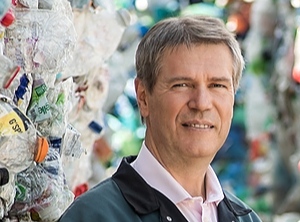PET RECYCLING AUSTRIA
PET to PET reports record recycling volume / “Significant” drop in demand expected by year-end
 Christian Strasser expects a significant decline in recyclate processing volumes in the second half of the year (Photo: PET to PET / Andi Bruckner) |
In the first half of the year, PET to PET Recycling Austria (Müllendorf; www.pet2pet.at) recycled 17,755 t of PET beverage bottles, an increase of more than 17% compared to the same period last year. One of the reasons for this increase is that PET to PET Recycling, in which beverage groups Coca-Cola HBC Austria, Egger, Rauch, S. Spitz, and Vöslauer Mineralwasser hold shares, expanded its production capacities in Müllendorf in Austria’s Burgenland region in 2022.
However, PET to PET Recycling has concerns regarding the rest of the year: “In the second half of the year, a significant decline in the use of recyclates is expected on the market, due to a persistently difficult economic situation, still very high inflation and, above all, a large price difference between first-use and recycled material,” explained managing director Christian Strasser. As in Germany, the neighbouring country also has specific quotas for the use of recycled PET bottles; by 2025 the share must be at least 25% and by 2030 even 30%.
Related: ARA files for patent on recycling residual plastics
In the meantime, the collection of lightweight packaging was standardised throughout Austria this year. Since January, plastic packaging such as yoghurt pots, plastic bags or tubes has been collected together with plastic bottles and beverage cartons in the yellow bags and bins of the Gelbe Tonne and Gelber Sack schemes. As part of this change, Altstoff Recycling Austria (ARA, Vienna; www.ara.at) expects plastic packaging volumes to increase by 20% in 2023.
In Austria, disposable plastic packaging must have a recycled content of 50% by 2025. “We (...) see it as a major challenge that there is still no specification for plastic packaging as to who is supposed to use these recyclates – and where,” Strasser warned.
However, PET to PET Recycling has concerns regarding the rest of the year: “In the second half of the year, a significant decline in the use of recyclates is expected on the market, due to a persistently difficult economic situation, still very high inflation and, above all, a large price difference between first-use and recycled material,” explained managing director Christian Strasser. As in Germany, the neighbouring country also has specific quotas for the use of recycled PET bottles; by 2025 the share must be at least 25% and by 2030 even 30%.
Related: ARA files for patent on recycling residual plastics
In the meantime, the collection of lightweight packaging was standardised throughout Austria this year. Since January, plastic packaging such as yoghurt pots, plastic bags or tubes has been collected together with plastic bottles and beverage cartons in the yellow bags and bins of the Gelbe Tonne and Gelber Sack schemes. As part of this change, Altstoff Recycling Austria (ARA, Vienna; www.ara.at) expects plastic packaging volumes to increase by 20% in 2023.
In Austria, disposable plastic packaging must have a recycled content of 50% by 2025. “We (...) see it as a major challenge that there is still no specification for plastic packaging as to who is supposed to use these recyclates – and where,” Strasser warned.
28.07.2023 Plasteurope.com [253296-0]
Published on 28.07.2023

 German version of this article...
German version of this article...